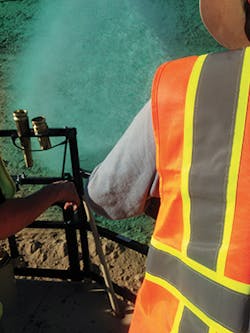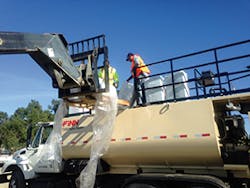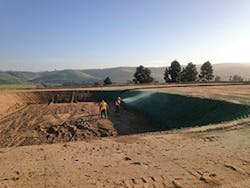In hydroseeding projects, it’s not only critical what product is applied, but the equipment used to apply it.
Time is of the essence, and having equipment with the power to cover large areas in a small amount of time is necessary not only in emergency jobs, but also in day-to-day projects that enable contractors to gain time and financial efficiencies.
Oroville Dam
The nation held its collective breath in February 2017 during the failure of the main and emergency spillways of the Oroville Dam in the Sierra Nevada foothills east of the Sacramento Valley, leading to the evacuation of 188,000 nearby residents.
The incident created an immediate erosion emergency. Selby’s Soil Erosion Control Co. was called in at the request of general engineering contractor Syblon Reid for the client, the California Department of Water Resources.
One of the largest erosion control companies on the West Coast, Selby’s Soil Erosion Control primarily serves an area north of Fresno, CA, to the Oregon border with 40 to 80 people and a fleet of nine hydroseeding machines. The backbone of the company’s work is for the California Department of Transportation (Caltrans) and for residential and commercial development.
The company has been involved in a number of high-profile jobs in California over the years, including post-fire hydroseeding in San Diego, the Valley, Butte, and Clayton. The company assisted another hydroseeding company in Idaho following a small fire there.
In the Oroville Dam project, the approach was to apply as much Rainier Bonded Fiber Matrix as quickly as possible to stabilize the area and reduce loss, notes Brandon Coppedge, the vice president of Selby’s Soil Erosion Control. That portion of the job was executed over three days in March with four hydroseeding machines and a crew of 10, he says.
One of the key pieces of equipment for the job was an Apex hydroseed applicator, purchased through Fiber Marketing International.
“Four thousand gallons is the distance and the capability of that particular machine,” notes Coppedge. “The Apexes are able to handle larger amount of mulch than some of the smaller hydroseeding machines. With their distance, our ability to shoot is definitely greatly increased.”
Coppedge sent six-by-six trucks to the site because of the steepness, the slope terrain, and the moisture.
“A lot of times, the spillway would be running and because of the way it broke, it created a lot of mist, so a lot of the soil was very slippery,” he says. “With all of the other contractors and all of the other equipment, getting around was definitely a little hard.”
To avoid having to travel back and forth, Coppedge kept several trucks onsite to meet the job’s timeline. The company also conducted a three-step heavy straw blanket process in some of the areas to keep moisture and warmth in to stimulate as much growth as possible.
“We were doing the work as fast as we could,” he says. “Most of our biggest trials were related to the rainy weather pattern. After initially buttoning up the site, we tried to come back to do some added work and maintenance. Because of the weather, a couple of the mobilizations were delayed because it was too slippery. Even with a six-wheel-drive truck, it was a challenge to get around. Having a hydroseeding machine that’s capable of getting the reaches that the Apex gets is definitely a huge advantage for us.”
Vegetation establishment was the primary goal.
“We’ll be back out there to continue monitoring and also continue erosion control measures,” says Coppedge.
State Route 241
California State Route 241 had existing erosion for which previous stabilization efforts had been unsuccessful. Caltrans hired Landscape Support Services to provide slope stabilization. The company, which employs up to 60 people, conducts erosion control and irrigation projects throughout southern and central California.
From November 2016 through March 2017, a crew of 18 from the company graded the slopes; applied different hydroseeding mixes, soil stabilizers, and bonded fiber matrix; and installed fiber netting afterward to cover the slopes and compost socks to slow down water.
Various native seeds sourced from S&S Seeds as well as ProGanics Biotic Soil Media were used on the project. The product is designed as a topsoil alternative to accelerate the development of depleted soils and substrates with low organic matter, low nutrient levels, and limited biological activity.
The rainy season provided many challenges, notes Chris Sturm, COO of Landscape Support Services. Dealing with disturbed slopes before the hydroseeding could be conducted proved to be another challenge.
“We had to apply soil stabilizer several times before we could get to the actual bonded fiber matrix,” notes Sturm. “For that, we used EarthGuard.”
EarthGuard Fiber Matrix combines EarthGuard and fiber to form a fiber-reinforced product for extended erosion control protection in severe situations.
Sturm notes that his company switched some of Caltrans’ specifications and substituted ProGanics for some of the specified soil amendments, yielding cost savings for the transportation client.
A residential development project in Chula Vista, CA
Chula Vista
In a 300-acre subdivision development project in Chula Vista, CA, a crew from The Land Stewards followed behind a grading operation to meet a 14-day requirement to install the erosion control and sediment control measures.
Central to the project’s success was the use of a 3,000-gallon FINN T330 HydroSeeder, which the company recently purchased. The machine’s working tank capacity of 3,000 gallons is designed to for large, demanding seeding projects such as mine reclamation, highways, and commercial and industrial sites.
The two-valve straight-line discharge piping is designed to improve slurry flow for higher output, pressure, and greater slurry discharge distance. Other features include hydraulically controlled paddle agitation. The machine’s “clump” technology integrates a single shaft design of the clutch and pump to maximize mechanical efficiency.
The agitator and pump are independently driven to enable complete slurry mixing without pump operation to enhance mechanical longevity and operational flexibility. A larger slurry pump coupled with a turbo-charged engine provides more pump pressure and output.
The discharge boom has been relocated to a more centralized location for increased operator comfort and rear sweeping pattern. The Tier III engine control panel integrates into the discharge boom mount with an engine start/stop, throttle switch, and pump control.
A newly designed loading hatch with a larger opening and curbside hinged lid is designed to enable more efficient loading. The machine has a discharge distance up to 230 feet from the end of the tower.
For the Chula Vista subdivision project, “We had our BMPs installed in a quick manner to be in compliance. By having larger machines, we’re able to do more acreage,” notes John Gentillon, owner of The Land Stewards.
The Land Stewards provides full-service stormwater management BMPs for public and private agencies, homebuilders, and general contractors with a workforce of 80. While the company works throughout the commercial, government, and residential sectors, it is most prevalent in the homebuilding realm.
On the subdivision project, Gentillon used a combination of Filtrexx fiber rolls and straw wattles in addition to a basic erosion control seed mix from S&S Seeds.
Time constraints were the biggest challenge, notes Gentillon.
“We’re trying to meet the letter of the law of the California general permit, getting our sediment control in in a timely manner to meet the 14-day non-use demand.”
Additional challenges entailed working in concert with a large grading operation.
Gentillon credits FINN representatives for visiting with his company employees to walk them through the equipment’s proper operation after its initial purchase. He says he likes that the machine is truck-mounted on a larger frame to offer better access to off-road types of jobs, in contrast to having to tow the equipment, which was presenting problems.
Gentillon also favors the machine’s maintenance features. “It’s easy to clean and easy to get parts,” he points out.
The FINN T330 helped The Land Stewards meet production deadlines. “That’s very important for us in staying on schedule and being cost-effective,” says Gentillon. “We get more work done to meet the demands of our business, which has been growing at a 20% clip a year over the last few years. Due to the better economy, we’re looking to grow more than that.”
Residential homebuilding is a driving factor, notes Gentillon.
Chula Vista, CA
“Most of the available lots that were graded during the economic downturn have been bought up and turned over, so there are new grading operations starting all over and we’re able to get more production done to meet the demand of our clients,” he adds.
The company has three FINN HydroSeeders of various capacities. Investing in the machines has enabled the company to get more done on a job—especially the ones on large acreage—and get more jobs done in a week, he notes.
Greening Alabama
Landscape the South provides a complete set of erosion control services from its base in Theodore, AL. The company has 16 employees.
Owner Joseph Mason says he had been doing some research and was “very pleased” with hydroseeding machines offered by Epic Manufacturing, so he purchased a 1,200-gallon skidmount unit to add to his existing fleet, which consists of a FINN T330 and a TurfMaker 550. The company works mainly on government and commercial hydroseeding projects.
“The Epic machine will discharge the mulch at 194 feet in some applications—we needed that without using the hose reel,” notes Mason. “There were areas we needed to get to, and some of the machines would not discharge that far.”
The machine was used on a recent hydroseeding project on a 200-acre residential site with a 15-acre lake. Landscape the South was asked to do soil stabilization around the pond on steep slopes.
Pulling the Epic Manufacturing machine on a tractor, a crew of three people applied a mixture of ProGanics Biotic Soil Media and Flexterra High-Performance Flexible Growth Medium on a 20-acre area earmarked for hydroseeding. Pulling the machine on a tractor was for the purpose of low ground impact around the job site, says Mason.
Faster Germination
Accelerated Green Works is a full-service landscaping contractor in West Fargo, ND. Brett Kallias, owner and director of operations, and his wife also are dealers for SYNLawn, a synthetic lawn product. Accelerated Green Works services the region’s commercial and residential markets.
The company uses Lesco Moisture Manager, a private label of Ecologel’s Hydretain, which is designed to reduce the watering requirements of plants and turf. Its blend of liquid humectant and hygroscopic compounds attracts free water molecules from the air within the soil matrix and transfers them into the roots of the plants.
“It helps out with my customers’ bottom dollar for water consumption and also makes my clients’ yards look better than the others,” notes Kallias. “People are trying to figure out what my clients are doing to their yards that other people aren’t doing to theirs.”
Kallias’ company often uses the granular form of the product in a broadcast spreader. When using the liquid form, he applies it with a FINN T90 HydroSeeder.
“I get about a 1,000 gallon tank. The average yard in Fargo takes about three tanks,” he says.
Kallias points out that the hotter the day, the more water is consumed. “A lot of people actually don’t know this, but a hydromulched yard is a lot better off than a sodded yard because with the hydromulched yard, the seeds germinate and then they’ve got to try to find moisture themselves.
“With the sod, it’s already green and growing and then you lay it on top of a finished-grade yard. Fargo soil has a lot of clay material and sod has a hard time in that tough soil. A hydromulched yard, if it’s done right, will germinate in seven to 10 days, while with Lesco Moisture Manager, we’re seeing yards germinate in up to five days if the conditions are right. And happy customers talk.”





